PROMO!
First order? Get 10% OFF with this code: 1storder
Our Product Categories
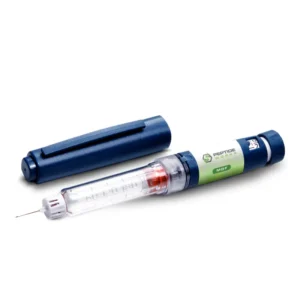
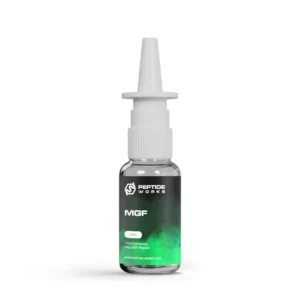
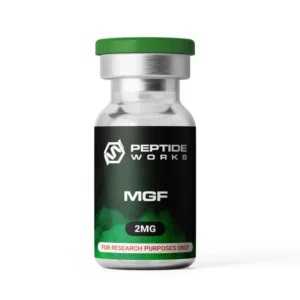
Mechano Growth Factor (MGF) is a tissue-specific isoform of IGF-1, generated by alternative splicing after muscle damage or mechanical stress. Unlike the more common IGF-1Ea, MGF acts locally and only for a short time, usually in skeletal muscle.
Its unique feature is a distinct 24-amino acid E-domain at the C-terminal end, created by the splicing process. This E-domain is essential for MGF to function. MGF’s main job is to stimulate satellite cells to multiply, which helps muscles repair and grow. It also prevents cells from differentiating too soon and helps them withstand injury-related stress.

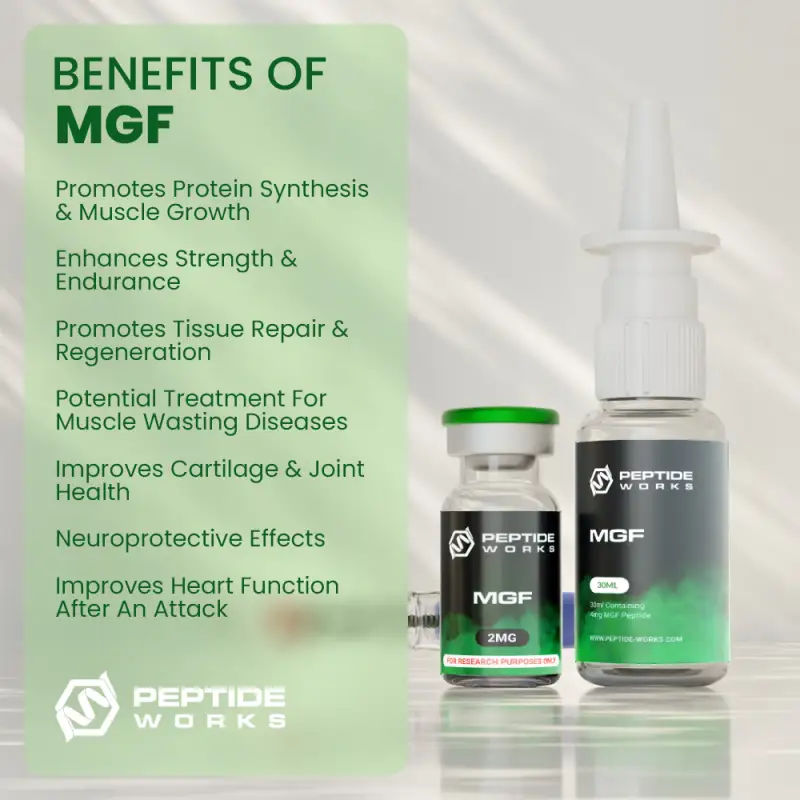
The biological effects of MGF are driven by its unique interaction with cellular pathways, separate from the traditional IGF-1 receptor (IGF-1R) signaling associated with its parent molecule.
While IGF-1Ea uses the IGF-1R, MGF’s E-domain does not bind effectively there. Instead, MGF appears to interact with an as-yet-unknown receptor, activating the MAPK/ERK pathway to promote rapid cell proliferation in satellite cells.
MGF’s ability to encourage cell growth without immediately causing differentiation is key to its function. It acts as a first responder, preparing the area for repair. After the satellite cell population has grown, MGF expression lessens. Other factors, like the systemic IGF-1Ea isoform, then take over to encourage the differentiation and fusion of these cells into new muscle.
Muscle Repair, Regeneration, and Satellite Cell Activation: Research has demonstrated that Mechano Growth Factor (MGF), a splice variant of IGF-1, plays a vital role in muscle repair and regeneration by activating satellite cells, promoting their proliferation, and delaying senescence. Studies have highlighted that MGF enhances muscle fiber growth (hypertrophy) and supports tissue repair in response to stress or injury [1].
It also modulates inflammation during muscle injury, influencing macrophage activity. In aging, MGF levels decline, contributing to muscle loss. Studies show MGF improves satellite cell function in younger muscles and may combat age-related sarcopenia [2]. Additionally, MGF promotes neurogenesis in the brain, highlighting its potential for both muscle and neural tissue regeneration [3].
Healing Bone, Tendons, and Ligaments: Mechano Growth Factor (MGF) plays a significant role in healing bones, tendons, and ligaments. In a rabbit bone-defect model, MGF-Ct24E enhanced osteoblast proliferation via the MAPK-Erk1/2 pathway and accelerated bone defect healing [4]. In another study on a rat Achilles tendon injury model, MGF-C25E improved tendon function, stiffness, and fiber alignment [5].
Additionally, studies on anterior cruciate ligament (ACL) repair showed that MGF E-peptide reduced hypoxia-induced apoptosis, promoted angiogenesis, and supported fibroblast survival through pathways like MEK-ERK1/2 and PI3K-Akt [6]. These findings highlight MGF’s potential as a therapeutic agent for musculoskeletal repair, offering promising applications in bone, tendon, and ligament regeneration.
Cartilage and Osteoarthritis:Recent studies show MGF E-peptide could help cartilage and treat osteoarthritis (OA). Research suggests it protects cartilage cells (chondrocytes) from stress, reduces cell death (apoptosis), and boosts the production of type II collagen and the extracellular matrix (ECM). This action seems to involve specific signaling pathways called PI3K-Akt and MEK-ERK1/2.
In studies on rats with osteoarthritis, MGF E-peptide was shown to slow down the breakdown of cartilage. It also increased levels of type II collagen and aggrecan, which helped improve the structure of the extracellular matrix (ECM). These promising results imply that MGF E-peptide may provide valuable protection for cartilage cells in challenging environments and could help slow the progression of OA, making it a potential therapeutic option for cartilage repair and management of the condition [7].
Neuroprotection and Neural‐Stem Cells: Research has shown that the Mechano Growth Factor C-terminal peptide demonstrates significant neuroprotective effects and potential in neural-stem cell support. In a gerbil model of brain ischemia, MGF peptide protected vulnerable neurons and increased endogenous MGF expression in ischemia-resistant hippocampal neurons, suggesting its role in natural neuroprotection.
In vitro, MGF peptide was as effective as full-length IGF-1 in preventing neurodegeneration, with longer-lasting effects and a unique mechanism independent of the IGF-1 receptor. These findings highlight MGF’s potential as a therapeutic agent for preventing neuronal damage and promoting neural repair, offering hope for conditions like ischemic stroke and neurodegenerative diseases [8].
Buy MGF Pre-Mixed Peptide Pen from Peptide Works. The 2 mg cartridge can be purchased separately or as part of a complete kit supplied with a reusable pen, needle tips, and a sturdy carry case designed for convenient and accurate preparation.
[1] P Kumar Kandalla, G Goldspink, G Butler-Browne, and V Mouly (2011) Mechano Growth Factor E peptide (MGF-E), derived from an isoform of IGF-1, activates human muscle progenitor cells and induces an increase in their fusion potential at different ages – Mechanisms of Ageing and Development, 2011 Apr, Volume 132 (Issue 4), Pages 154-62.
[2] K-T Sun, K-K Cheung, S W. N. Au, et al (2018) Overexpression of Mechano-Growth Factor Modulates Inflammatory Cytokine Expression and Macrophage Resolution in Skeletal Muscle Injury – Frontiers in Physiology, 2018 Jul 26, Volume 9, Page 999.
[3] J J Tang, J L Podratz, M Lange, et al (2017) Mechano growth factor, a splice variant of IGF-1, promotes neurogenesis in the aging mouse brain – Molecular Brain volume 10, Article number: 23 (2017).
[4] M Deng, B Zhang, K Wang, et al (2010) Mechano growth factor E peptide promotes osteoblasts proliferation and bone-defect healing in rabbits – International Orthopaedics, 2010 Nov 6, Volume 35 (Issue 7), Pages 1099–1106.
[5] B Zhang, Q Luo, D Kuang, et al (2016) Mechano-growth factor E peptide promotes healing of rat injured tendon – Biotechnology Letters, 2016 Oct, Volume 38 (Issue 10), Pages 1817-25.
[6] Y Sha, L Yang, Y Lv, et al (2019) MGF E peptide improves anterior cruciate ligament repair by inhibiting hypoxia-induced cell apoptosis and accelerating angiogenesis – Journal of Cellular Physiology, 2019 Jun, Volume 234 (Issue 6), Pages 8846-8861.
[7] Y Sha, W Cai, A Mohanad Khalid, et al (2021) Pretreatment with mechano growth factor E peptide attenuates osteoarthritis through improving cell proliferation and extracellular matrix synthesis in chondrocytes under severe hypoxia – International Immunopharmacology, 2021 Aug, Volume 97, Page 107628.
[8] J Dluzniewska, A Sarnowska, M Beresewicz, et al (2005) A strong neuroprotective effect of the autonomous C-terminal peptide of IGF-1 Ec (MGF) in brain ischemia – FASEB Journal, 2005 Nov, Volume 19 (Issue 13), Pages 1896-8.
The answers to the most frequently asked questions about the MGF peptide.

Buy MGF Peptide Nasal Spray from Peptide Works. Offered in 15ml and 30ml glass spray bottles, this non-invasive administration route for research
MGF (Mechano Growth Factor) helps muscles repair and grow after hard workouts. It signals muscle cells to start recovery and may support new muscle cell growth over time. In research, MGF shows increased activity in muscle tissue following mechanical stress or damage. While it mainly aids repair, consistent recovery can lead to stronger, fuller muscles. It supports healing more than instant size gain.
Yes. MGF (Mechano Growth Factor) is prohibited for athletes under the World Anti-Doping Agency (WADA) regulations. It falls under the category of peptide hormones and growth factors that may enhance muscle growth or recovery. Possession or administration of MGF in drug-tested sports can lead to disqualification or suspension.
MGF (Mechano Growth Factor) is not approved by the FDA for human use in the United States. However, it can be legally sold and purchased for laboratory or research purposes. Regulations may vary from country to country, so buyers should always review local laws before ordering. MGF offered for research use only complies with current U.S. guidelines for scientific study.
Research on MGF (Mechano Growth Factor) in humans is still limited, so its complete safety profile is not known. In laboratory and animal studies, MGF has been linked to temporary injection site redness, swelling, or irritation. Some experimental findings also suggest a potential risk of unwanted tissue growth if MGF spreads beyond targeted areas.
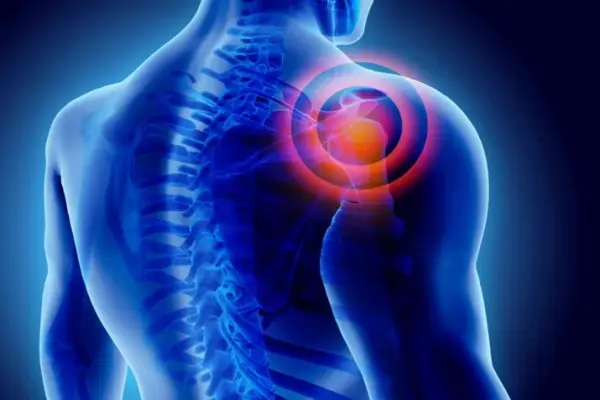
This blog explores the fascinating world of growth and repair peptides, with a focus on MGF (Mechano Growth Factor) and its improved form, PEG-MGF. It looks at how these peptides support muscle regeneration, activate satellite cells and aid protein synthesis, while also addressing the balance between growth and myostatin inhibition. Learn more about the latest research driving muscle recovery and repair.

This blog explores muscle-building peptides such as Ipamorelin, CJC-1295, MK-677, and MGF. It describes how these compounds help increase growth hormone, IGF-1, and protein synthesis to support muscle growth and recovery. Learn more about their research potential from studying muscle development to improving therapies for rehabilitation and age-related muscle decline.

This blog explores the comparison between MGF and PEG-MGF, two peptides that are widely researched for their roles in growth and recovery. It explains how PEGylation helps improve stability, extends half-life and leads to better results in research. The article also looks at related peptides such as GDF-8 and Ipamorelin, offering insights into their roles in muscle growth and metabolic health.
ALL CONTENT AND PRODUCT INFORMATION AVAILABLE ON THIS WEBSITE IS FOR EDUCATIONAL PURPOSES ONLY.
DISCLAIMER: These products are intended solely as a research chemical only. This classification allows for their use only for research development and laboratory studies. The information available on our Peptide Works website: https://peptide-works.com/ is provided for educational purposes only. These products are not for human or animal use or consumption in any manner. Handling of these products should be limited to suitably qualified professionals. They are not to be classified as a drug, food, cosmetic, or medicinal product and must not be mislabelled or used as such.